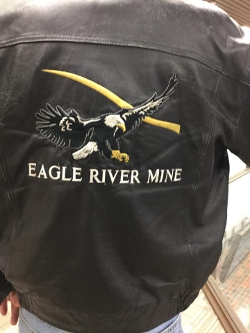 It's pretty much the first thing they teach you as an underground miner.
It's pretty much the first thing they teach you as an underground miner.
Avoid the bottoms of holes.
Holes are dangerous places.
People die at the bottoms of holes because stuff falls down them all the time.
Rubble near the edge on higher levels topples in.
Rocks cleave off the walls.
Tools get dropped.
Rocks are the deadliest, though.
Even if they’re ricocheting down the shaft walls, often you won't hear falling rocks until you're dead.
Rock on rock doesn't make much noise at all.
Metal on rock is noisier, but even then, you may not hear it if there's a big noisy ventilation fan near you.
On April 30, 2013, there was a big, noisy ventilation fan near where they found Dominic Bernard at the bottom of a 36-metre high raise, a nearly vertical underground working that had been excavated from the bottom up in the Wesdome Eagle River Gold Mine, 50 kilometres due west of Wawa.
Bernard was a 35-year-old mine supervisor from Blind River who had worked at Eagle River for eight of the 19 years the mine had been in production.
He was by all accounts a well-seasoned, safety-conscious miner.
He was in good health.
An extensive Ministry of Labour investigation found nothing amiss in the mine’s equipment, training or safety procedures.
So what was Bernard doing at the bottom of a raise where he was well aware he could be instantly killed?
We will never know.
For the past two days, a coroner’s inquest has reviewed the death of Dominic Bernard, and come up dry on that question.
Witnesses offered no suggestions on how to prevent such deaths in the future.
The jury made no recommendations.
The three-man, two-woman jury concluded that Bernard’s death was accidental, resulting from “blunt impact (crush) trauma to head.”
Testimony indicated that Bernard’s body was found buried under a muck pile at the base of the raise.
Miners searched for their supervisor for some time before one noticed what appeared to be blood in the water around the muck pile.
Ron Hauguth, mining health and safety inspector with the Ministry of Labour, believes the muck had nothing to do with Bernard’s death, that it was piled on later, after something struck the supervisor’s head and ended his life.
Earlier, Bernard himself had given the go-ahead for slushing to begin, a process that used a heavy steel blade to pull muck to the raise, where it was flushed down.
“I believe [the accident] happened before the actual mucking began,” Hauguth testified. “He was underneath the mud pile. He wasn't in the middle of it.”
Was it possible that Bernard became ill and somehow stumbled over a barricade into the raise?
No.
Hauguth said that, in compliance with government regulations, barricades were in place nine metres away from the raise.
It’s obvious, he said, that Bernard, for some reason, entered the raise intentionally, dangerous as that was.
Hauguth, who himself worked 20 years as a miner and supervisor in Elliot Lake before moving to the Ministry of Labour, puts the accident down to human error.
“I believe it was a tragic accident, a poor decision made. I believe he made an improper decision,” Hauguth told the jury and the coroner, Dr. Shelagh McRae of Gore Bay.
Dana Peterson, counsel to the coroner, went further, hinting that Bernard may have ventured into the raise to retrieve a restrictor valve that had apparently fallen from an Alimak raise climber, a piece of equipment that lifts and lowers two workers within the raise, protecting them with a safety roof.
“Evidence seems to suggest that this was an accident that was a result of human error,” Peterson said.
She described Bernard as an “experienced, capable, competent miner, not a reckless cowboy."
“This seems to be completely out of character for such a careful person,” Peterson said. “We will never know why he was under the raise.”
Also testifying today was Dan Boychuk, owner of Dan Boychuk Mining, which employed Bernard to work in the mine.
Boychuk said that it was obvious to workers using the raise climber earlier on the day Bernard died that the restrictor valve was missing – they could hear it as the platform was lowered.
The valve regulates speed so the climber doesn’t descend too quickly, but it isn’t necessary for safe operation of the equipment, Boychuk said. “It came off at some point,” he said.
Miners are never to go into a raise without a safety roof over their heads.
Usually, the raise climber is used for this purpose.
Bernard didn’t use it to enter the raise.
Boychuk Mining was represented at today’s inquest by Caroline Richard of the Ottawa law firm Bird Richard.
Richard pointed out that Bernard was alone at the time of the accident and he is therefore the only one who knows what happened and knows why he entered the raise in contravention of regulations, counter to all his training and to his own personality of safety.
“For reasons unknown, he placed himself under an open raise and was hit by debris,” Richard said.